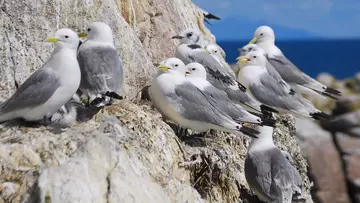
ZSL
Zoological Society of London
Wind farm developers are being urged to factor local seabird population trends into plans to avoid contributing to species decline, says new ZSL-led study.
Offshore windfarm developments could avoid adding to the plight of wild birds such as the black-legged kittiwake, by ensuring that the most recent data on local populations is considered when planning, says new study from ZSL.
Research published today in Conservation Science and Practice shows that although the UK has some of the best seabird monitoring activity anywhere in the world, key data is being ignored during offshore windfarm planning assessments.
Around the world, seabirds are experiencing long-term population decline, with climate change and reduction in food sources as the key drivers. These threats are compounded for seabirds in the UK, which now face additional risks from poorly planned offshore wind energy development.

Renewable energy from wind farms is set to quadruple within the next decade, and although this is good news for reducing carbon emissions, seabirds are at risk of displacement from feeding sites, and even death due to collisions with turbine blades.
Developers often rely on a tool called a Population viability analysis (PVA) to assess potential impacts to vulnerable species, such as seabirds. These assessments typically use summary data to predict how future seabird populations might fare. However, many species of seabird such as cliff-nesting gulls like the Kittiwake (Rissa tridactyla) are experiencing ongoing population decline due to other pressures. Not taking these existing drivers of change into consideration when assessing the potential impacts from windfarms could influence developers’ understanding of how already struggling species are likely to respond.
ZSL and UCL (University College London) conservation scientist and lead author of the study, Catharine Horswill said: “If existing drivers of population change are not considered during assessments, future threats are likely to be underestimated. We need wind farms to tackle the climate crisis but protecting biodiversity must also be a priority. We need to tighten up assessments to make sure that potential impacts to already struggling wildlife, such as the Kittiwake, are better understood.
Do you remember when bees were always buzzing, not disappearing? Or the last time you saw a hedgehog rustling in the leaves? Climate change and human activity have pushed our precious planet to its limit causing massive habitat and species loss. When nature loses, we all do. Urgent action to help people and wildlife live better together, is the only way to save the natural world we love and depend upon. That’s where ZSL comes in, and where you can play your part.
